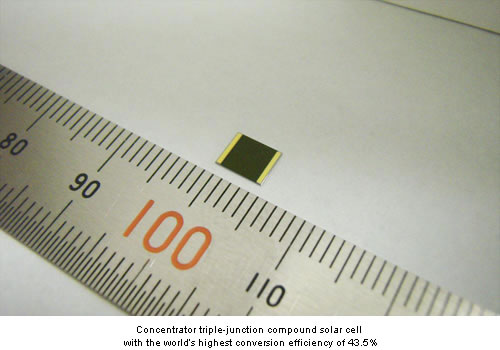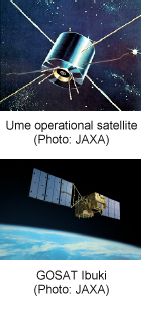
Sharp Corporation has achieved the world’s highest solar cell conversion efficiency*1 of 43.5%*2 using a concentrator triple-junction compound solar cell. These solar cells are used in a lens-based concentrator system that focuses sunlight on the cells to generate electricity.
Compound solar cells utilize photo-absorption layers made from compounds consisting of two or more elements, such as indium and gallium. The basic structure of this latest triple-junction compound solar cell uses Sharp’s proprietary technology that enables efficient stacking of the three photo-absorption layers, with InGaAs (indium gallium arsenide) as the bottom layer.
To achieve this latest increase in conversion efficiency, Sharp capitalized on the ability of this cell to efficiently convert sunlight collected via three photo-absorption layers into electricity. Sharp also optimized the spacing between electrodes on the surface of the concentrator cell and minimized the cell's electrical resistance.
This latest Sharp breakthrough came about through research and development efforts that are part of the "R&D on Innovative Solar Cells" project promoted by Japan’s New Energy and Industrial Technology Development Organization (NEDO).*3 Measurement of the value of 43.5%, which sets a record for the world’s highest concentrating conversion efficiency, was confirmed at the Fraunhofer Institute for Solar Energy Systems (ISE)*4 in Germany.
Because of their high conversion efficiency, compound solar cells have been used primarily on space satellites. Sharp's aim for the future is to apply this latest development success into concentrator photovoltaic power systems that can efficiently generate electricity using small-surface-area solar cells and make them practical for terrestrial use.

- *1 As of May 30, 2012, for concentrator solar cells at the research level (based on a survey by Sharp).
- *2 Conversion efficiency confirmed by the Fraunhofer Institute for Solar Energy (ISE; one of several organizations around the world that officially certifies energy conversion efficiency measurements in solar cells) in April 2012 under a light-concentrating magnification of 306 times (cell surface: approx. 0.167 cm2). 43.5% is the same conversion efficiency achieved by Solar Junction of the United States in March 2011.
- *3 NEDO is one of Japan’s largest public management organizations for promoting research and development as well as for disseminating industrial, energy, and environmental technologies.
- *4 ISE was one of the participating members from the EU side at "NGCPV: A new generation of concentrator photovoltaic cells, modules and systems". The collaboration is part of the "R&D in Innovative Solar Cells" project.
History of Sharp Compound Solar Cell Development
| 1967 |
Development begins of solar cells for space applications using single-crystal silicon. |

|
| 1976 |
Launch of operational Japanese satellite, “Ume,” equipped with Sharp solar cells for space applications (single-crystal silicon solar cell). |
| 2000 |
Research and development begin on triple-junction compound solar cells to further improve efficiency, reduce weight, and increase durability of solar cells for space applications. |
| 2001 |
Participation in research and development on NEDO’s photovoltaic power generation themes. |
| 2002 |
Triple-junction compound solar cell gains certification from the Japan Aerospace Exploration Agency (JAXA). |
| 2003 |
Conversion efficiency of 31.5% is achieved (at the research level) for a triple-junction compound solar cell. |
| 2005 |
Launch of small scientific satellite, “Reimei,” equipped with Sharp triple-junction compound solar cells. |
| 2007 |
Conversion efficiency of 40.0% achieved (at the research level) for a triple-junction compound solar cell (concentrator type, at 1,100 times concentrated sunlight). |
| 2009 |
Launch of Greenhouse gases Observing SATellite (GOSAT), “Ibuki”, equipped with Sharp triple-junction compound solar cells. |
| 2009 |
Conversion efficiency of 35.8% is achieved (at the research level) for a triple-junction compound solar cell based on research and development efforts that are part of NEDO’s “R&D on Innovative Solar Cells” project. |
| 2011 |
Conversion efficiency of 36.9% is achieved (at the research level) for a triple-junction compound solar cell based on research and development efforts that are part of NEDO’s “R&D on Innovative Solar Cells” project. |
| 2012 |
Conversion efficiency of 43.5% is achieved (at the research level) for a concentrator triple-junction compound solar cell based on research and development efforts that are part of NEDO’s “R&D on Innovative Solar Cells” project. |